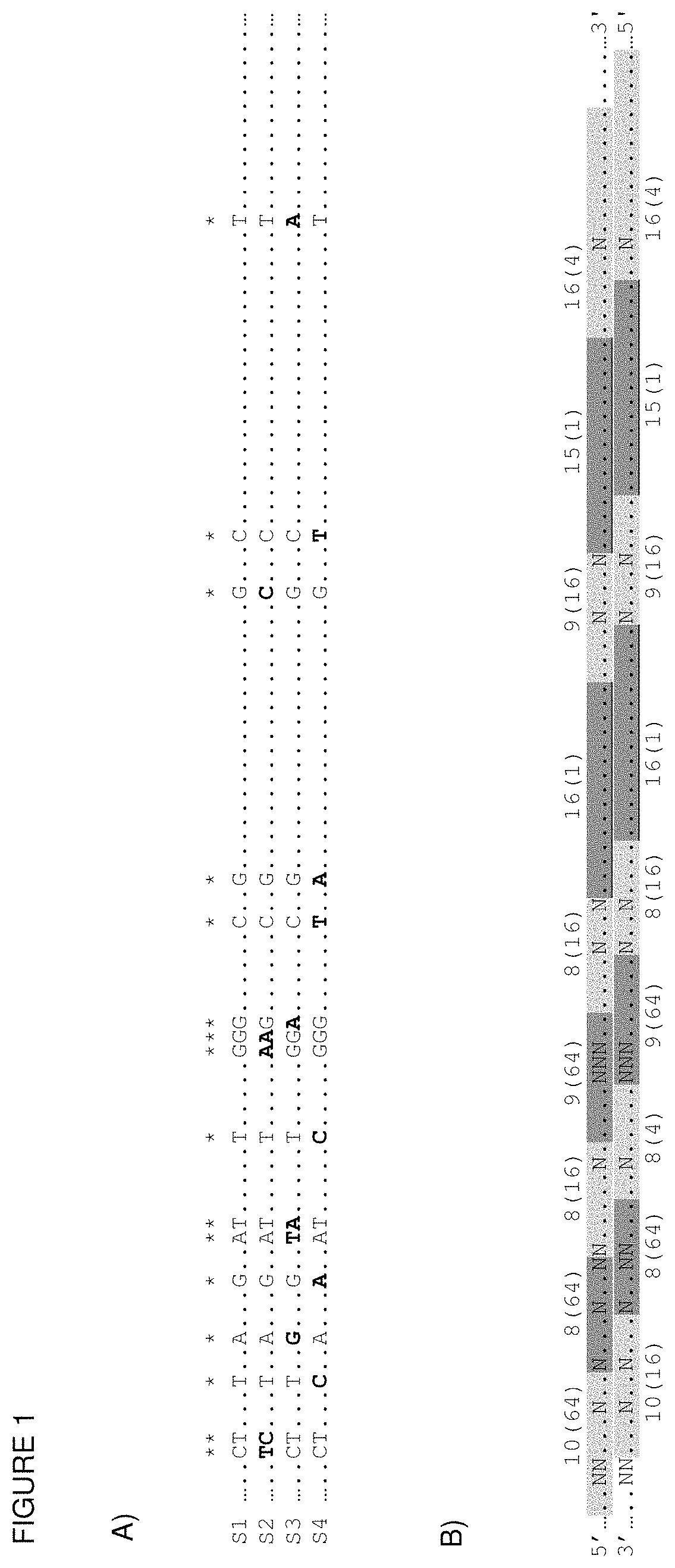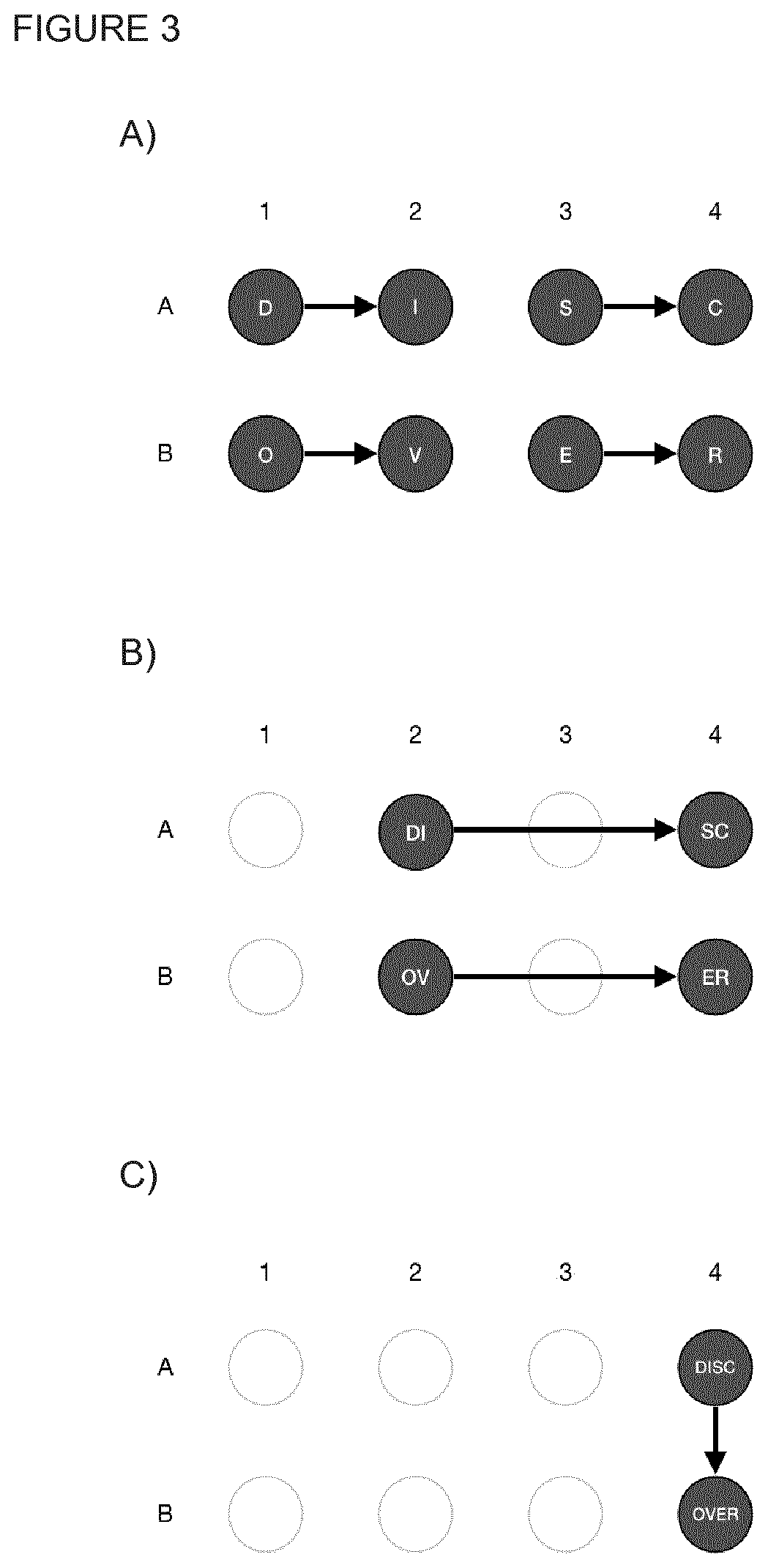Method for synthesis of polynucleotides using a diverse library of oligonucleotides
a polynucleotide and library technology, applied in the field of polynucleotide synthesis using a diverse library of oligonucleotides, can solve the problems of limiting the size of the molecules, unsuitable for large-scale commercial use, and dramatic reduction of the yield of the reaction, so as to shorten the time to synthesize
- Summary
- Abstract
- Description
- Claims
- Application Information
AI Technical Summary
Benefits of technology
Problems solved by technology
Method used
Image
Examples
example 1
n of the Library
[0189]1.1 Determining the Spatial Structure of the Genetic Information
[0190]A. First, all the sequences of oligonucleotides that are to be included in the library have to be listed. These sequences are pre-computed from an input set of sequences that cover all potentially desired targets. This information can come from a diversity of criteria, such as a subset of possible combinations (e.g. all heptamers, all octamers, etc.), predicted outcome of the digestion of a genome with a set of restriction enzymes or any other computational criterion.
[0191]In this example the Human mitochondrial genome (Gene Bank accession nr. J01415; Anderson et al., 1981), which has 16569 base pairs, served as basis for the library. Ideally, all reported sequences would be taken and processed in the same way as described below and in FIG. 1.
[0192]The reference genome sequence was partitioned into oligonucleotide dimers of lengths between 8 and 26 bp. Similarly, the reverse-complement was co...
example 2
of a Target DNA Molecule of 128 bp
[0229]In this example it was demonstrated how to synthesize a sequence of 128 bp by means of the method proposed herein. FIG. 2A shows the sequence of interest, which was termed DISCOVER, and was built from 16 matching pairs (FIG. 2B) that formed 8 ds oligos of 16 nt with 4 nt overhangs on each strand (see FIG. 2C) and 8 complementary sites. Each ds oligo is denoted by the letters D, I, S, C, O, V, E, R and their constituting leading and lagging strands by + and − superscripts, respectively. The oligos were part of the library generated in example 1. It has the following properties: all oligos were phosphorylated at the 5′ end, they were provided at a concentration of 200 μM on nuclease free ddH20 and the used oligos were single-stranded and pure.
[0230]A. Preparing the Annealing Solutions.
[0231]In a reaction tube 252 μL on ddH20 with TRIS-HCl (50 mM), MgCl2 (10 mM), DTT (10 mM) and ATP (1 mM) were prepared. The pH was set to 7.5. Some commercial buf...
example 3
essing of Target DNA Sequences for Complex Sequences or RNA Synthesis
[0251]3.1 Design of Proxy ds Polynucleotide
[0252]In this example a ds polynucleotide was synthesized whose workflow would normally include an ambiguous step such as self-complementary oligo dimer (e.g. FIG. 5A). Since such a self-complementary dimer has to be excluded from the workflow to avoid unwanted runaway reactions, a template sequence was devised by replacing the self-complementary elements with different bases, in such a way that the resulting assembly workflow was unambiguous. According to this template, a proxy ds polynucleotide was synthesized.
[0253]In FIG. 5A the sequence of interest is depicted. The underlined parts indicate those parts of the sequence capable of self-complementation and self-polymerization. In order to avoid these sequences a template sequence (FIG. 5B) was designed which comprises two base pair modifications that span three oligos.
[0254]The proxy ds polynucleotide was synthesized wit...
PUM
| Property | Measurement | Unit |
|---|---|---|
| volume | aaaaa | aaaaa |
| volume | aaaaa | aaaaa |
| volume | aaaaa | aaaaa |
Abstract
Description
Claims
Application Information
 Login to View More
Login to View More - Generate Ideas
- Intellectual Property
- Life Sciences
- Materials
- Tech Scout
- Unparalleled Data Quality
- Higher Quality Content
- 60% Fewer Hallucinations
Browse by: Latest US Patents, China's latest patents, Technical Efficacy Thesaurus, Application Domain, Technology Topic, Popular Technical Reports.
© 2025 PatSnap. All rights reserved.Legal|Privacy policy|Modern Slavery Act Transparency Statement|Sitemap|About US| Contact US: help@patsnap.com



